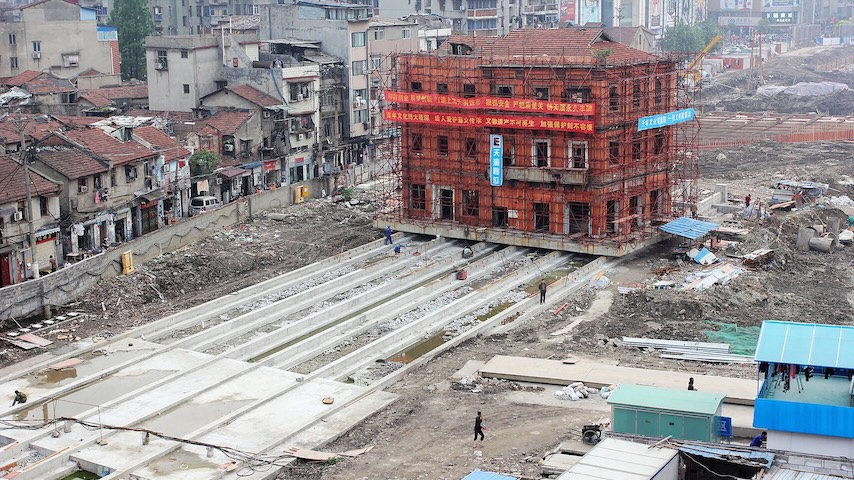Energy Blog: Learning How to Beat the Heat
Energy Blog: Learning How to Beat the Heat


If you’re from Texas like I am, you are accustomed to hot weather. But the epic heatwave that descended on Europe in late June was a whole other beast. Wildfires broke out in Spain, spontaneously igniting—among other things—farmers' manure piles. Towns in France hit 45 °C (113 °F), breaking heat records for the instrumental age.
Even though I'm used to heatwaves, hot summers, and scorching sidewalks, a 105 °F day in Austin, Texas, is easier to take than a 95 °F day in Paris, where I’m writing this column. In Texas, the ubiquity of air conditioning, ice, swimming pools, shade, and screens on windows mean that hot days there are manageable. In France, when it gets this hot, there is no escaping the heat.
Because Paris is in a northern location with a cooler climate, Parisians design their buildings to retain heat rather than shed it. The buildings don’t allow airflow that would let heat escape and thus are more energy efficient in winter. What’s more, limestone, granite, and other rock are typical building materials—one of the reasons Paris is considered one of the most beautiful cities in the world.
But lack of ventilation traps heat in buildings in hot weather, and stone holds a lot of heat and reflects a lot of light, exacerbating the urban heat island effect.
It isn’t just infrastructure. France does not have an “ice” culture the way Texas does. In Texas, ice is served in water, tea, sodas, and most other drinks. In France, restaurants won’t put ice in water unless it’s requested, and even then it is usually just a few cubes of ice for a glass of water.
Listen to Renewable Energy Experts Shine Light on Solar Farms and Grids
Infrastructure and culture can interact to stymie common cooling solutions. Take windows: The classic French window is tall with glass panes that can either swing open or be covered by working shutters. (Most shutters in the U.S. are merely decorative.) Such windows work well for letting in fresh air or defending against prowlers, but they make installing window air conditioning units awkward or impossible. An alternative—mini-split systems that place the compressor on the roof and pipe in chilled refrigerant through the walls—has trouble cooling large spaces and can be difficult to retrofit into the older building stock typical of Paris.
As a result, home air conditioning in France lags the United States. That difference can have deadly consequences. When a heat wave hit Europe in 2003, up to 70,000 people died across the continent, including more than 15,000 (mostly elderly) people in France. And cultural idiosyncrasies played a major role: The heatwave hit in August, the traditional vacation month in France, so fewer doctors were on call. Elderly people, not used to intense summer heat, didn’t have fans and didn’t know to stay hydrated.
Compounding things, many elderly lived on fixed incomes and could only afford top-floor apartments in walk-up buildings. Those apartments are hotter than the average home.
To avoid such a disaster during the 2019 heatwave, public officials waived entrance fees for swimming pools and closed un-air-conditioned schools at mid-day so kids could cool off at home. They also recommended people go to movies or shopping malls. (This was a big selling point for American cinemas before home air conditioning was common.) But the shopping malls in France have weak ACs and were crammed with people—who went there to cool off—so they were hot and stuffy. My family went to a modern mall one early evening during the heat wave, and it was hotter inside than outside.
All of these factors reveal the complexity of climate change and the need for localized solutions, as the challenges will vary. Labor, medical, and housing policies will play an important part. Some of the infrastructural concepts common in hot climates, such as shade trees and better ventilated buildings as well as more widespread air conditioning, will have to be adopted by places that have up to now been more focused on fending off winter chill.
Most importantly, one key takeaway is that if rich, developed countries in northern latitudes have trouble adapting to climate change, just imagine how tough it will be for poorer, hotter regions as they get even hotter.
Michael E. Webber is the Josey Centennial Professor of Energy Resources at the University of Texas in Austin and Chief Science and Technology Officer at ENGIE, a global energy company headquartered in Paris. His latest book, Power Trip: The Story of Energy, is published by Basic Books.
This article is reprinted from Mechanical Engineering magazine.
Did you like this blogpost? Read more articles by Webber:
Global Talent Can Make American Industry Stronger
Give Us Freedom to Walk Bike
Even though I'm used to heatwaves, hot summers, and scorching sidewalks, a 105 °F day in Austin, Texas, is easier to take than a 95 °F day in Paris, where I’m writing this column. In Texas, the ubiquity of air conditioning, ice, swimming pools, shade, and screens on windows mean that hot days there are manageable. In France, when it gets this hot, there is no escaping the heat.
Because Paris is in a northern location with a cooler climate, Parisians design their buildings to retain heat rather than shed it. The buildings don’t allow airflow that would let heat escape and thus are more energy efficient in winter. What’s more, limestone, granite, and other rock are typical building materials—one of the reasons Paris is considered one of the most beautiful cities in the world.
But lack of ventilation traps heat in buildings in hot weather, and stone holds a lot of heat and reflects a lot of light, exacerbating the urban heat island effect.
It isn’t just infrastructure. France does not have an “ice” culture the way Texas does. In Texas, ice is served in water, tea, sodas, and most other drinks. In France, restaurants won’t put ice in water unless it’s requested, and even then it is usually just a few cubes of ice for a glass of water.
Listen to Renewable Energy Experts Shine Light on Solar Farms and Grids
Infrastructure and culture can interact to stymie common cooling solutions. Take windows: The classic French window is tall with glass panes that can either swing open or be covered by working shutters. (Most shutters in the U.S. are merely decorative.) Such windows work well for letting in fresh air or defending against prowlers, but they make installing window air conditioning units awkward or impossible. An alternative—mini-split systems that place the compressor on the roof and pipe in chilled refrigerant through the walls—has trouble cooling large spaces and can be difficult to retrofit into the older building stock typical of Paris.
As a result, home air conditioning in France lags the United States. That difference can have deadly consequences. When a heat wave hit Europe in 2003, up to 70,000 people died across the continent, including more than 15,000 (mostly elderly) people in France. And cultural idiosyncrasies played a major role: The heatwave hit in August, the traditional vacation month in France, so fewer doctors were on call. Elderly people, not used to intense summer heat, didn’t have fans and didn’t know to stay hydrated.
Compounding things, many elderly lived on fixed incomes and could only afford top-floor apartments in walk-up buildings. Those apartments are hotter than the average home.
To avoid such a disaster during the 2019 heatwave, public officials waived entrance fees for swimming pools and closed un-air-conditioned schools at mid-day so kids could cool off at home. They also recommended people go to movies or shopping malls. (This was a big selling point for American cinemas before home air conditioning was common.) But the shopping malls in France have weak ACs and were crammed with people—who went there to cool off—so they were hot and stuffy. My family went to a modern mall one early evening during the heat wave, and it was hotter inside than outside.
All of these factors reveal the complexity of climate change and the need for localized solutions, as the challenges will vary. Labor, medical, and housing policies will play an important part. Some of the infrastructural concepts common in hot climates, such as shade trees and better ventilated buildings as well as more widespread air conditioning, will have to be adopted by places that have up to now been more focused on fending off winter chill.
Most importantly, one key takeaway is that if rich, developed countries in northern latitudes have trouble adapting to climate change, just imagine how tough it will be for poorer, hotter regions as they get even hotter.
Michael E. Webber is the Josey Centennial Professor of Energy Resources at the University of Texas in Austin and Chief Science and Technology Officer at ENGIE, a global energy company headquartered in Paris. His latest book, Power Trip: The Story of Energy, is published by Basic Books.
This article is reprinted from Mechanical Engineering magazine.
Did you like this blogpost? Read more articles by Webber:
Global Talent Can Make American Industry Stronger
Give Us Freedom to Walk Bike



